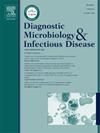Marked temporal decline in human herpesvirus-8 seroprevalence among people living with HIV in Istanbul, Türkiye
IF 1.8
4区 医学
Q3 INFECTIOUS DISEASES
Diagnostic microbiology and infectious disease
Pub Date : 2025-07-30
DOI:10.1016/j.diagmicrobio.2025.117037
引用次数: 0
Abstract
Human herpes virus 8 (HHV-8) drives Kaposi’s sarcoma and other lymphoproliferative disorders, especially in PLWH. There are differences in the prevalence of HHV-8 according to countries and geographical regions. Current knowledge on HHV-8 infection in Türkiye relies on sparse and outdated data, leaving a significant gap. To close this knowledge gap, we aimed to generate an up-to-date estimate of HHV-8 seroprevalence in PLWH in Istanbul, Türkiye.
In this study, a cross-sectional sero-survey of 368 PLWH whose blood samples were referred from six tertiary hospitals in Istanbul. HHV-8 IgG antibodies were detected with a commercial ELISA. Demographic data and HIV-RNA results accompanied each specimen. Categorical variables were compared with χ² or Fisher’s exact tests; continuous variables with independent-samples t-tests (p < 0.05).
HHV-8 IgG antibodies were detected in 3 % of PLWH. No seropositive cases occurred in the 0–30-year age group, whereas rates peaked in the 51–60 (5.3 %) age group. Seropositivity was 4.2 % in females and 2.8 % in males (p > 0.05). Among HIV-RNA–positive patients, HHV-8 positivity was 3.4 % versus 2.7 % in HIV-RNA–negative patients (p > 0.05).
This multicenter representative study reveals that HHV-8 circulation among PLWH in Istanbul has declined to a low level. The absence of antibodies in younger adults suggests a recent reduction in saliva-mediated transmission, potentially linked to pandemic-driven measures. By providing the first robust sero-epidemiological estimate in over a decade, the study supplies an essential baseline for future public-health planning in Türkiye.
在土耳其伊斯坦布尔,艾滋病毒感染者中人类疱疹病毒-8血清阳性率显著下降
人类疱疹病毒8 (HHV-8)驱动卡波西肉瘤和其他淋巴细胞增生性疾病,特别是在PLWH中。根据国家和地理区域,HHV-8的患病率存在差异。目前关于基耶病毒8型肝炎病毒感染的知识依赖于稀疏和过时的数据,留下了重大空白。为了缩小这一知识差距,我们旨在对土耳其伊斯坦布尔PLWH中HHV-8血清阳性率进行最新估计。在这项研究中,对伊斯坦布尔六所三级医院转诊的368名PLWH的血液样本进行了横断面血清调查。采用商用ELISA检测HHV-8 IgG抗体。每个样本都附有人口统计数据和HIV-RNA结果。分类变量比较采用χ 2或Fisher精确检验;具有独立样本的连续变量t检验(p <;0.05)。3%的PLWH检测到HHV-8 IgG抗体。0- 30岁年龄组无血清阳性病例发生,而51-60岁年龄组阳性率最高(5.3%)。血清阳性率女性为4.2%,男性为2.8% (p >;0.05)。在hiv - rna阳性患者中,HHV-8阳性为3.4%,hiv - rna阴性患者为2.7% (p >;0.05)。这项多中心代表性研究表明,伊斯坦布尔PLWH中的HHV-8循环已降至低水平。年轻人中抗体的缺失表明,唾液介导的传播最近有所减少,这可能与大流行驱动的措施有关。通过提供十多年来第一个可靠的血清流行病学估计,该研究为未来基耶岛公共卫生规划提供了一个基本基线。
本文章由计算机程序翻译,如有差异,请以英文原文为准。
求助全文
约1分钟内获得全文
求助全文
来源期刊
CiteScore
5.30
自引率
3.40%
发文量
149
审稿时长
56 days
期刊介绍:
Diagnostic Microbiology and Infectious Disease keeps you informed of the latest developments in clinical microbiology and the diagnosis and treatment of infectious diseases. Packed with rigorously peer-reviewed articles and studies in bacteriology, immunology, immunoserology, infectious diseases, mycology, parasitology, and virology, the journal examines new procedures, unusual cases, controversial issues, and important new literature. Diagnostic Microbiology and Infectious Disease distinguished independent editorial board, consisting of experts from many medical specialties, ensures you extensive and authoritative coverage.

 求助内容:
求助内容: 应助结果提醒方式:
应助结果提醒方式:


